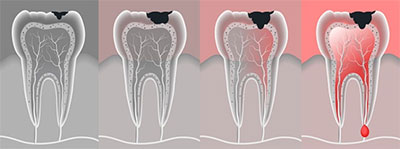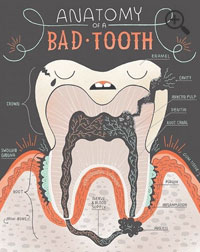

The term "root canal" comes from cleaning of the canals inside the tooth's root.
A root canal treatment is generally initiated to repair and save a badly damaged or infected tooth.
The procedure involves removing the damaged area of the tooth (the pulp), cleaning and disinfecting it and then filling and sealing it.
The common causes affecting the pulp are a cracked tooth, a deep cavity, repeated dental treatment to the tooth or trauma.
You may need one if you are experiencing any of the following symptoms:





Step 1:- X-ray - if a dentist suspects you may need a root canal, he will first take X-rays or examine existing X-rays to show where the decay is located.

Step 2:- 2Anesthesia - local anesthesia is administered to the affected tooth. Contrary to popular belief, a root canal is a painless procedure.

Step 3:- Pulpectomy - an opening is made and the diseased tooth pulp is removed.

Step 4:- Filling - the roots that have been opened (to get rid of the disease pulp) are filled with gutta-percha material and sealed off with cement/composite.

Step 5:- Crown - A permanent crown or a similar type of restoration is paced on the top of the treated tooth. Depending on the condition of your natural tooth, the dentist may need to place a small supporting post inside of the root chamber, to make the crown or restoration more stable.